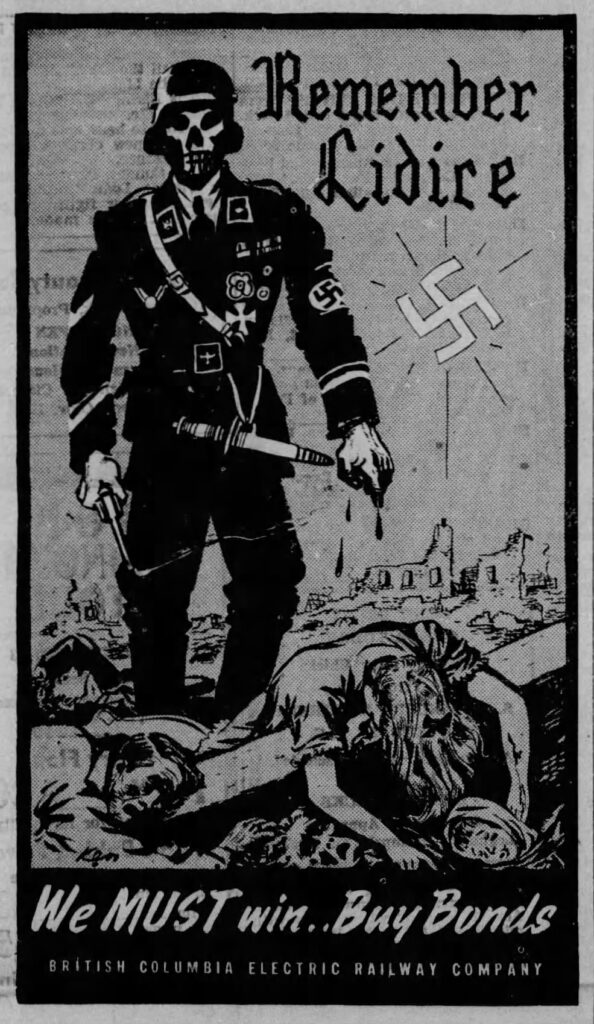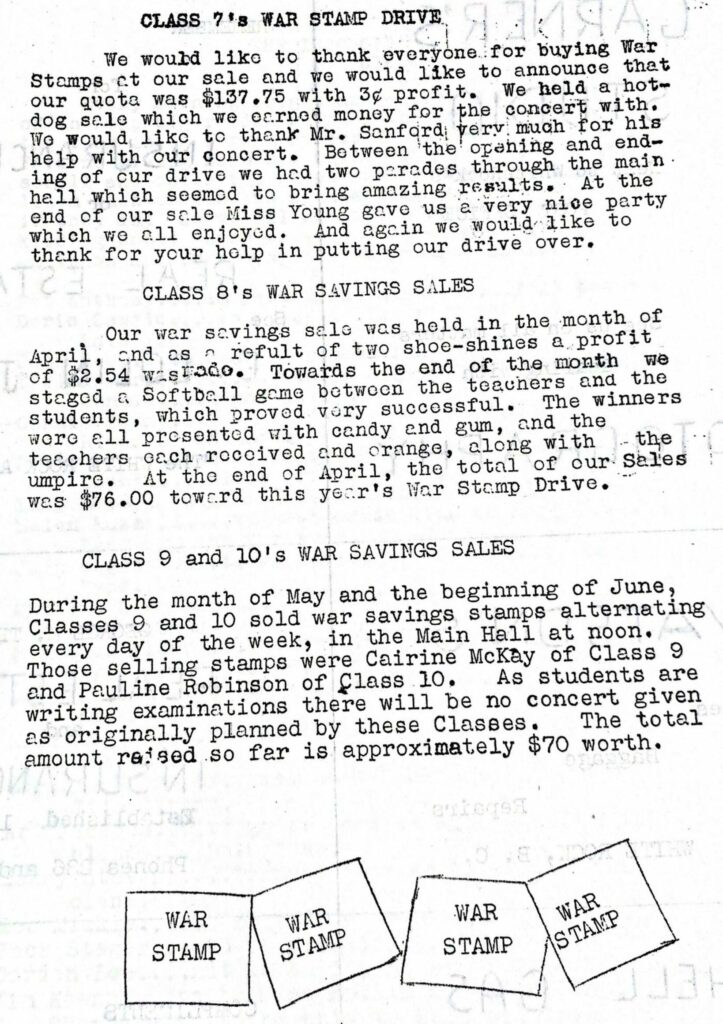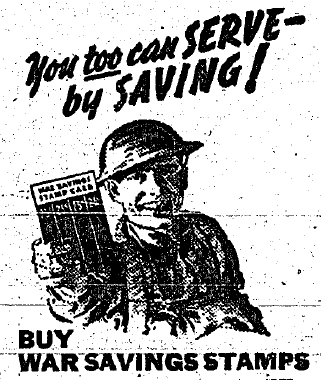
School activities outside of the official curriculum encouraged nationalistic ideas and supported the war effort. This includes certain clubs, such as the Junior Red Cross, whose members, typically female, worked on sewing and knitting materials for the troops and refuges. At Surrey High School the Handicraft Club joined with the Red Cross club in order to collaborate on making garments for refugee children. The school reporter commented that the school appreciated their patriotism. The Red Cross Club also held fundraising events, such as teas, in order to gain money for the war effort. Service was considered an essential value to the Junior Red Cross, with a student reporter at Lord Tweedsmuir High School commenting that the students felt that it was important for them, as well as the other schools in the area to do their part in taking care of the soldiers abroad and those at home, “by making scarves, sweaters, and many other articles of comfort for them.” Eventually students began receiving Red Cross pins after completing articles to show their dedication. The club was seen as the way that female students could do their part with the war effort, and it was often mentioned alongside the cadet activities that the boys were doing. Some schools in BC made Red Cross activities mandatory. Other clubs that were considered War Services clubs that girls did during cadet training include home-nursing, first-aid, and Hi-Y which focused on fundraising activities.1
The two sources of revenue that the government depended on during WWII were taxation and borrowing, with the government using borrowing in order to account for half of the money needed for its financial requirements. One way to get this money was through Victory Loans from the public buying savings bonds, called Victory Bonds, as well as War Savings Certificates. Propaganda was used in order to manipulate the public into purchasing these, which influenced adults and children alike. Children were more likely to purchase the 25 cent war stamps, rather than the more expensive Victory Bonds. The plan was for students to fill cards with 16 stamps, which would cost $4 total, and then exchange these cards for a $5 War Savings Certificate, which would the earn interest for seven and a half years to be worth $5.70. This was a successful endeavor in schools, with about $750,000 being raised by BC students through selling war stamps.2
High schools in Surrey certainly participated in this. Stamps would be sold in school, and often there would be competitions to see which class bought the most War Savings Stamps. In 1940 the principal of Queen Elizabeth High School gave away one stamp to the first twenty-five students who brought in a card with fifteen stamps. Semiahmoo High School even started a “V” club in order to manage “war activities, such as salvage drives and the sale of War Savings stamps,” Peer pressure was regularly used to persuade students to buy stamps. In Surrey pressure was used through each class having posters with squares with the students’ names, which would be filled with a sticker once a stamp was purchased. These posters themselves brought more nationalistic sentiments into schools, with slogans such as “Help Stamp out Hitler” along with being decorated with flags and maple leaves.3


Competition was used in more than just the selling of War Savings stamps; it was also used in the advertising of stamps, as well as Victory Loans. Queen Elizabeth High School hosted a contest for students to submit the best Victory Loan slogan and the winner would receive a $5 War Savings certificate. There were multiple essay contests that prompted students to explain why Victory Bonds should be purchased. Students also competed to design Victory Loan posters. Students were asked to participate in additional war efforts, including salvage drives to gain materials like aluminum and silver paper, which was often facilitated as a competition.4
“Every loyal citizen who can afford it should buy Victory Bonds. Without the support of the public, the government cannot hope to meet the tremendous expense of fighting machinery of men who operate these instruments of war. Besides these reasons is the love of freedom which every man bears in his heart. We in Canada cannot realize that there is actually a war going on across the sea, nor can we realize that there is a growing possibility of that war spreading to our shores. It is up to us, the people of Canada, to decide whether or not this danger remains only a possibility and not a probability. This danger balances on the amount of Victory Bonds sold.”
Jim Anthony, Grade 8, Semiahmoo High School. 2nd prize essay. “Why We Should Buy Victory Bonds.” The Surrey Leader (Surrey, BC, Canada), June 18, 1941. Accessed through Surrey Archives.

Additional Newspaper Advertisements for Wartime Savings



Next Page → Wartime School Events
References
- S. Fallowfield. “Lord Tweedsmuir High.” The Surrey Leader (Surrey, BC, Canada), November 10, 1943. Accessed through Surrey Archives.; Emilie L. Montgomery “‘The War Was a Very Vivid Part of My Life’: British Columbia School Children and the Second World War,” 1991. https://search.ebscohost.com/login.aspx?direct=true&AuthType=sso&db=ddu&AN=6709D90C094B80FA&site=eds-live., 109.; Lorraine Parton & Ellina Jacobson. “Among the Students.” The Surrey Leader (Surrey, BC, Canada), November 22, 1939. Accessed through Surrey Archives.; The School Reporter. “Among the Students.” The Surrey Leader (Surrey, BC, Canada), October 25, 1939. Accessed through Surrey Archives.; The School Reporter. “Among the Students.” The Surrey Leader (Surrey, BC, Canada), September 24, 1941. Accessed through Surrey Archives.; The School Reporter. “War Services Clubs Meet at Queen Elizabeth.” The Surrey Leader (Surrey, BC, Canada), November 11, 1942. Accessed through Surrey Archives.; The Student Reporter. “Among the Students.” The Surrey Leader (Surrey, BC, Canada), October 15, 1940. Accessed through Surrey Archives. ↩︎
- Montgomery “The War Was a Very Vivid Part of My Life,” 109-111. ↩︎
- “Air Cadets Started at Semiahmoo High School.” The Surrey Leader (Surrey, BC, Canada), November 11, 1942. Accessed through Surrey Archives.; “Among the Students.” The Surrey Leader (Surrey, BC, Canada), February 26, 1941. Accessed through Surrey Archives.; Montgomery “The War Was a Very Vivid Part of My Life,” 111.; “Port Mann Brevities.” The Surrey Leader (Surrey, BC, Canada), October 23, 1940. Accessed through Surrey Archives. ↩︎
- “School Contest will Commence on Monday.” The Surrey Leader (Surrey, BC, Canada), April 28, 1943. Accessed through Surrey Archives.; The Lord Tweedsmuir Reporter. “Among the Students.” The Surrey Leader (Surrey, BC, Canada), October 21, 1942. Accessed through Surrey Archives.; The School Reporter. “Among the Students.” September 24, 1941.; The School Reporter. “Queen Elizabeth High.” The Surrey Leader (Surrey, BC, Canada), May 6, 1942. Accessed through Surrey Archives.; The Student Reporter. “Queen Elizabeth High.” The Surrey Leader (Surrey, BC, Canada), June 18, 1941. Accessed through Surrey Archives. ↩︎